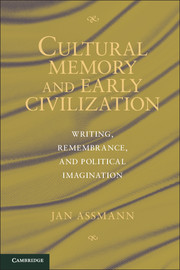Foreword (2010)
Published online by Cambridge University Press: 05 June 2012
Summary
Twenty-five years ago when Aleida Assmann and I discovered “Cultural Memory” as a topic for a common book project, we embarked on what was then a small river of discourse. Today, the river has grown into a sea. Cultural memory has become a central concern, not only for archaeology and comparative literature, the two disciplines in the context of which we started, but also within all branches of cultural studies as well as history, arts, and even politics. However, the very fact that we began our research at such an early stage when the foundations of this field had still to be set down may have saved our books from becoming soon outdated by being just part of a passing fashion. There is very little that I found necessary to change for the English edition except for updating the bibliography. The field has since evolved in many directions, but the theoretical foundations proved stable as did the Ancient World with which the case studies are concerned.
For an Egyptologist, cultural memory is a likely concept to study, especially for two reasons. First, Egypt was reputed, in antiquity, to be the civilization with the longest memory whose monuments and annals stretched back into time immemorial. The past stood visibly and constantly before Egypt as a model to follow, and the Egyptians made great efforts not to let the monuments of their past fall into ruin and oblivion. Is this a special case? Or, is it a typical form of a culture or society to deal with its past? Second, Ancient Egypt, do we think of it as part of our own past or rather as a foreign, exotic world? Is it a matter of memory or of (re)discovery? And what is the difference? What is the nature of this mysterious shadow-line that separates remembered from discovered past, for example, the Homeric epics or the biblical psalms from the Pyramid Texts?
- Type
- Chapter
- Information
- Cultural Memory and Early CivilizationWriting, Remembrance, and Political Imagination, pp. xi - xiiPublisher: Cambridge University PressPrint publication year: 2011

